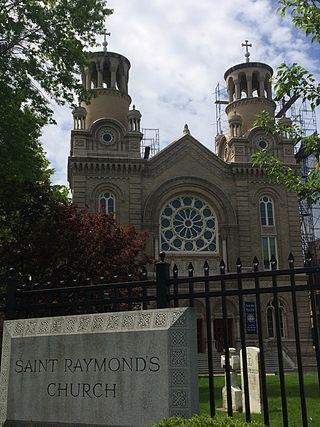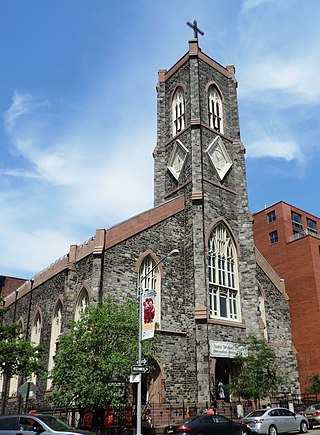
The Church of the Holy Rosary was a Roman Catholic parish church under the authority of the Roman Catholic Archdiocese of New York, located at 444 East 119th Street, East Harlem, Manhattan, New York City.

St. Lucy's Church is a former parish church of the Parish of St. Lucy, which operated under the authority of the Archdiocese of New York in the East Harlem section of the Borough of Manhattan in New York City. The parish address was 344 East 104th Street; the parochial school occupied 336 East 104th Street. The parish merged with St. Ann's Church in 2015, and Masses and other sacraments are no longer offered regularly at this church.

Church of St. Thomas the Apostle is a former Roman Catholic parish church in New York City that had been threatened with demolition. It was the subject of a landmarks preservation debate. The parish was established in 1889; staffed by the Salesians of Don Bosco from 1979 to 2003; and closed in 2003 because of a diminished congregation and structural problems.

The Church of the Sacred Heart of Jesus is a Roman Catholic parish church, located in Hell's Kitchen/Clinton, Manhattan, New York City. Founded in 1876, it is a parish of the Archdiocese of New York and is located at 457 West 51st Street. Sacred Heart of Jesus School is located at 456 West 52nd Street. Since 2009, the pastor has been the Rev. Gabriel Piedrahita.

The Immaculate Conception Roman Catholic Church is located at Front and Allen Streets in Philadelphia, PA 19123 in the Northern Liberties, Philadelphia, Pennsylvania section of the city; after over 140 years as an independent parish, it became a worship site of the adjacent St. Michael's parish in 2011. The parish celebrated its 150th anniversary in 2019, having been founded in 1869 under the leadership of Bishop James Frederick Wood. Twenty-five years earlier, two Catholic parishes within about a mile of the church—St. Augustine Church, Philadelphia at 4th and Vine and St. Michael at 2nd and Jefferson—were burnt to the ground in violent anti-Catholic nativist riots. The church continued as an independent parish or as a worship site for almost 150 years until, in the fall of 2019, it was announced that the church building would be closed permanently.
Church of St. Emeric was a Roman Catholic parish church in the Roman Catholic Archdiocese of New York, located at Avenue D, between 12th Street and 13th Street, Manhattan, New York City. The address is 740 East 13th Street. When restoration was completed on St. Brigid's on Avenue B in 2013, the Church of St. Emeric was closed and the parishes merged to form the parish of St. Brigid-St. Emeric.

The Church of St. John the Evangelist is a Roman Catholic parish church in the Roman Catholic Archdiocese of New York, located at 355 East 55th Street at First Avenue, Manhattan, New York City.

The Church of the Holy Innocents is a Catholic parish church in the Archdiocese of New York, located at 128 West 37th Street at Broadway, Manhattan, New York City.

The Church of St. Anthony is a Roman Catholic parish church under the authority of the Roman Catholic Archdiocese of New York, located at 1496 Commonwealth Avenue, Van Nest, Bronx, New York City, near the corner of Mansion Street and Commonwealth Avenue. Founded in 1908 as an Italian Personal Parish.

St. Raymond's Church is a parish church under the authority of the Roman Catholic Archdiocese of New York, located at Castle Hill Avenue at Tremont Avenue, The Bronx, New York City. The parish was established in 1842. It was dedicated on the feast of St. Raymond Nonnatus, on August 31, 1845, thus getting its name. There is a stained glass window, on the right side if you are looking at the sanctuary, of St. Raymond Nonnatus and the men who took him hostage.
The Church of St. Columba is a Roman Catholic parish church under the authority of the Roman Catholic Archdiocese of New York, located in Hopewell Junction, Dutchess County, New York State.

The Old Church of St. Peter is a Roman Catholic church established under the authority of the Roman Catholic Archdiocese of New York in Poughkeepsie, Dutchess County, New York in 1837. It is the second oldest Catholic Church on the Hudson and is considered the Mother Church of the Hudson Valley because from it all the parishes in Ulster and Dutchess counties were founded. The church is also referred to as Our Lady of Mount Carmel since 1965 when St. Peter's parish relocated to Hyde Park, New York and the parish of Our Lady of Mount Carmel church relocated to site.
The Church of St. Mary is a Roman Catholic parish church under the authority of the Roman Catholic Archdiocese of New York, located in Wappingers Falls, Dutchess County, New York. It was canonically established in 1845.
The Old Church of St. Rose of Lima is a former Roman Catholic parish church which was under the authority of the Roman Catholic Archdiocese of New York, located at 36 Cannon Street between Broome Street and Delancey Street in the Lower East Side of Manhattan, New York City. The rectory was located at 42 Cannon Street; the school was located at 290 Delancey Street. The 1871 church was described by The New York Times when it opened in 1871, as one of the finest churches in the city. The church was demolished around July 1901 and the site redeveloped in conjunction with the erection of the Williamsburg Bridge (1903) and public housing. A new church was begun shortly after property was purchased in July 1900 at Grand and Lewis Streets. The parish closed in the 1960s.

The Church of St. Mary is a former Roman Catholic parish church under the authority of the Roman Catholic Archdiocese of New York, located at White Plains Road at 215th Street in Williamsbridge, Bronx, New York City, New York. The church served the Williamsbridge area along with a parish school on East 215th Street, and later in the 1950s was closed and relocated to Carpenter Avenue and East 224th Street to accommodate the growing student population and shift of parishioners. The parish church was closed partly due to the community's changing demographics in the 1990s, reducing the Catholic population to a point where the Archdiocese of New York could no longer support a Catholic parish in the area.

St. Michael's Roman Catholic Church is an active parish of the Roman Catholic Archdiocese of Philadelphia located at Second and Jefferson Streets in Philadelphia, in the West Kensington section of the city.

The Church of the Blessed Sacrament is a Roman Catholic parish located in New Rochelle, New York. Blessed Sacrament was founded in 1874 and its present-day church building was constructed in 1897. Its predecessor, St. Matthew's Church, was founded in 1848. Blessed Sacrament Church is listed as a New Rochelle Historic Site.
The history of St. Mary's Church in Dedham, Massachusetts begins with the first mass said in Dedham, Massachusetts in 1843 and runs to the present day.



















